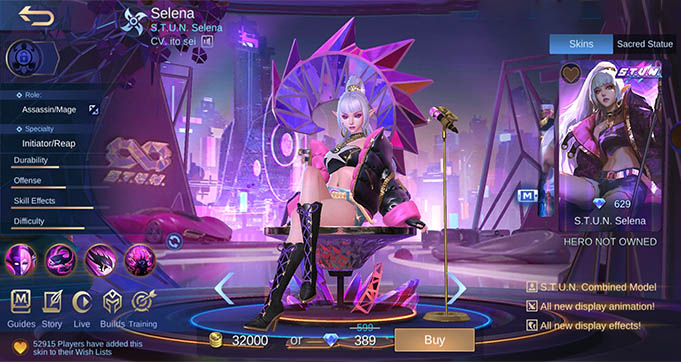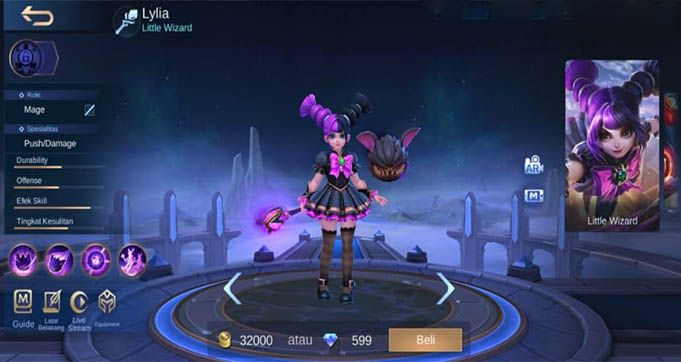Fans of Mobile Legends Bang Bang are certainly familiar with hearing the name of the hero Kadita, a Mage type hero who is quite feared for the deadly skills he has. Apart from that, Kadita can also heal herself by adding blood automatically when attacking minions or enemy heroes. If you want to use a hero, especially if you are a cloud player or new, of course it is very important to continue practicing to get to know more about this hero. Because Kadita is not very easy to use compared to other mage heroes.
There are 4 tips that you can learn to start using the Kadita hero well to win the game. The following is the explanation:
- Located in Mid Lane
Hero mages are always placed in the Mid Lane, which is a rule when starting the game. This will also make it easier for the mage hero to visit a friend’s lane at the top or bottom if they need help. - Target the opposing team’s Marksman/Mage
To win, the opponent’s target that must be aimed at is the opponent’s Marksman or Mage hero. Take advantage of all skill combinations and ultimates to kill your opponent quickly. Use skill 2 first so that the opponent is affected by crowd control, then skill 1 to swim towards the opponent, then use the ultimate which releases a strong water explosion towards the enemy. - Hiding in the Grass
The grass is a strategic place for Kadita to hide and wait for an opponent who is careless to launch an effective attack. If the opponents who come are tanks and assassins, you should immediately move away to avoid threatening enemy attacks. - Use Skill 1 to stay away from your opponent
Skill 1, which is attack power, of course has other functions that can be used to avoid or escape from opponents in emergency situations. Make sure you are not careless when carrying out an attack by paying attention to the map in the right corner of the gadget screen so you don’t get attacked by a group of opponents.
3 Best Heroes to Face Kadita in Mobile Legends
What if in the game you met Kadita as an opposing player, it would definitely be a bit thrilling, wouldn’t it? No need to worry, because we will discuss several heroes who are ready to fight to defeat Kadita well. Here are the 3 best Hero recommendations that you can rely on to take over the game.
Kagura

Kagura is a Mage hero who has the best and most effective anti-CC abilities to use in facing Kadita’s terror. Kagura’s Skill 2 is able to easily avoid Kadita’s combination of airborne effects and high burst damage. Apart from that, Kagura’s skill 1, which throws an umbrella a certain distance at the opponent, is certainly effective in provoking Kadita’s passive skill to become active. This will make Kagura’s next attack even more deadly against Kadita. With burst magic with high damage, Kagura can eliminate Kadita from a distance.
Selena

Selena’s hero skill, which is admired by gamers, is being able to reveal the whereabouts of hiding opponents. Skill 1 used by Selena, which creates traps anywhere, will of course reveal the whereabouts of opponents around the trap. With this ability, Selena can help teammates hunt enemies more easily, especially Kadita who is always hiding in the grass. When Kadita is caught in a trap, this will make Kadita’s passive skills active and make her more vulnerable to opponent attacks. At the same time, Selena can use a stun skill on Kadita to make it difficult for her to avoid deadly attacks. It should be noted that high precision is required in using skill 2 to hit the opponent effectively and specifically.
Lylia

Lylia, who is also a Mage hero, can be relied on to avoid Kadita’s deadly combination of attacks. Ultimate Skill that can make Lylia teleport to Black Shoes 4’s previous location when she sees Kadita preparing to make an attack move. The advantage of skill 2 on Lylia is that it can restore the total stack of the other skill, accompanied by HP recovery of up to 20%. Lylia’s slow skill is very effective at targeting Kadita so she can’t escape any attacks.
So, that’s the best information about the Mobile Legends game which can increase your knowledge to continue to win Legends. Come on, continue participating in Ranked battles and get exclusive hero skins!